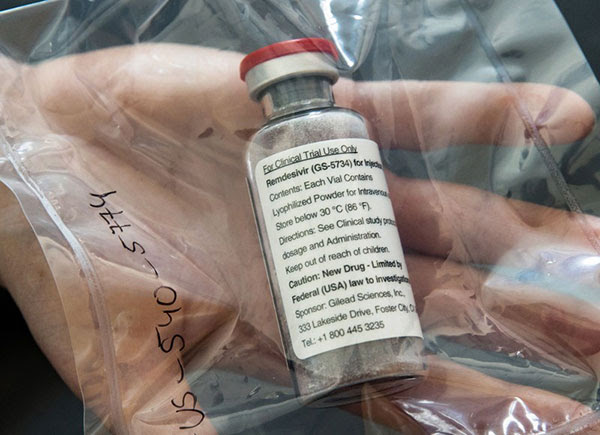skip to main |
skip to sidebar
Dozens of coronavirus drugs are in development — what happens next?
Dozens of coronavirus drugs are in development — what happens next?
 Production of remdesivir, an antiviral drug approved to treat COVID-19, is ramping up. (Ulrich Perrey/POOL/AFP/Getty)
Dozens of coronavirus drugs are in development (for example, there were encouraging drips of data from a large clinical trial of the antiviral remdesivir last month). Next, we face the challenge of ramping up complex manufacturing processes to produce sufficient quantities of successful therapies to treat everyone in need. Drug manufacturers face supply-chain weaknesses and sourcing issues. And each treatment will face different challenges when scaling up production. (Nature | 7 min read)
The government of Togo wants to send cash payments to thousands of vulnerable households. In Uganda, the local phone company is helping to direct government assistance to people in vulnerable communities. In Bangladesh, the government hopes to use phone records to determine who is eligible for emergency assistance. All these efforts could dramatically increase the timeliness and effectiveness of humanitarian responses — while minimizing the need for face-to-face contact, argues information-scientist Joshua Blumenstock. He outlines how the immense privacy risks and practical challenges of these methods can be overcome with the cautious use of machine learning. (Nature | 5 min read)
Lessons from the Black Death in fourteenth-century London and smallpox in Native American communities 400 years later can teach us about the unequal toll of epidemics. Researchers who study those outbreaks, and others, are uncovering how racism, oppression and poverty made a lie of the ‘equal-opportunity killer’. “The ways that social inequalities are manifested … put people at higher risk,” says historian Monica Green. “We should all be learning in our bones, in a way that will never be forgotten, why [the coronavirus pandemic] has happened the way it has.” (Science | 13 min read)
The Jackson Laboratory (JAX) in the United States has become a nucleus in researchers’ efforts to understand COVID-19 in mouse models. After a warning from a colleague in China, the lab rushed to produce stocks of transgenic mice using frozen sperm from SARS-susceptible animals developed by prescient microbiologist Stanley Perlman. JAX is also acting as an ark for carefully bred mouse colonies that scientists elsewhere were forced to cull when their labs closed. Lab leader and neuroscientist Cat Lutz describes the lab’s round-the-clock work. (Knowable | 8 min read)
Production of remdesivir, an antiviral drug approved to treat COVID-19, is ramping up. (Ulrich Perrey/POOL/AFP/Getty)
Dozens of coronavirus drugs are in development (for example, there were encouraging drips of data from a large clinical trial of the antiviral remdesivir last month). Next, we face the challenge of ramping up complex manufacturing processes to produce sufficient quantities of successful therapies to treat everyone in need. Drug manufacturers face supply-chain weaknesses and sourcing issues. And each treatment will face different challenges when scaling up production. (Nature | 7 min read)
The government of Togo wants to send cash payments to thousands of vulnerable households. In Uganda, the local phone company is helping to direct government assistance to people in vulnerable communities. In Bangladesh, the government hopes to use phone records to determine who is eligible for emergency assistance. All these efforts could dramatically increase the timeliness and effectiveness of humanitarian responses — while minimizing the need for face-to-face contact, argues information-scientist Joshua Blumenstock. He outlines how the immense privacy risks and practical challenges of these methods can be overcome with the cautious use of machine learning. (Nature | 5 min read)
Lessons from the Black Death in fourteenth-century London and smallpox in Native American communities 400 years later can teach us about the unequal toll of epidemics. Researchers who study those outbreaks, and others, are uncovering how racism, oppression and poverty made a lie of the ‘equal-opportunity killer’. “The ways that social inequalities are manifested … put people at higher risk,” says historian Monica Green. “We should all be learning in our bones, in a way that will never be forgotten, why [the coronavirus pandemic] has happened the way it has.” (Science | 13 min read)
The Jackson Laboratory (JAX) in the United States has become a nucleus in researchers’ efforts to understand COVID-19 in mouse models. After a warning from a colleague in China, the lab rushed to produce stocks of transgenic mice using frozen sperm from SARS-susceptible animals developed by prescient microbiologist Stanley Perlman. JAX is also acting as an ark for carefully bred mouse colonies that scientists elsewhere were forced to cull when their labs closed. Lab leader and neuroscientist Cat Lutz describes the lab’s round-the-clock work. (Knowable | 8 min read)









No hay comentarios:
Publicar un comentario